Frank Gehry was one of the absolute first designers to employ cardboard in furniture design, starting with the Wiggle Side Chair in 1972. Manufacturers had been seeking an alternative to plastic since the 1960s, but struggled to find anything that could compete with its light flexibility.

Image source: https://en.wikipedia.org/wiki/Frank_Gehry#/media/File:Frank_O._Gehry_-_Parc_des_Ateliers_(cropped).jpg
Ghery’s Project
According to Vitra, the Swiss contemporary furniture company that has produced Gehry’s cardboard furniture designs since 1986, the architect saw a pile of corrugated cardboard outside his office one day and began to experiment from there.
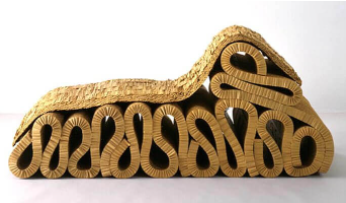
Image source: https://insteading.com/blog/cardboard-furniture/
One day I saw a pile of corrugated cardboard outside of my office – the material which I prefer for building architecture models – and I began to play with it, to glue it together and to cut it into shapes with a hand saw and a pocket knife.
– Frank Gehry
Ghery’s project is the perfect example of Ecodesign: an ecologic and enviromental friendly object made out of recycled materials, combined with low impact production and recycling processes.
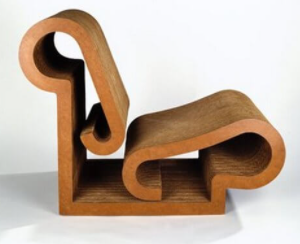
Image source: https://insteading.com/blog/cardboard-furniture/
Easy Edge
Easy Edges is the name given to a series of furniture designs by Frank Gehry, lasting from 1969 to 1973. These early designs were partially responsible for Gehry’s rise to public recognition in the early 1970s. After discovering that corrugated cardboard layered enough times in alternate directions builds strength into the piece and make it suitable for the everyday use, Gehry used this as a trampoline to produce a series of pieces of furniture such as the “Easy Edges Wiggle Side Chair” that take advantage of the versatility of cardboard as a medium. Gehry’s use of cardboard as a medium demonstrates his “fundamental concern with manipulating basic materials in unconventional ways to produce objects that are functional yet also visually striking”.
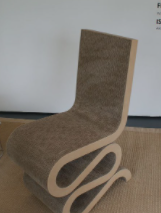
Image source: https://search.creativecommons.org/photos/2ad225ec-19b4-49c5-8621-dfb5a59ca9f1 by puffin11uk
However, the Easy Edges series never reached high production volumes due to sales prices exceeding rates Gehry had expected. That, in addition to Gehry’s aversion to the role of a furniture designer rather than that of an architect resulted in a cessation of production until in 1986 Vitra AG relaunched four models from the Easy Edges series into production including the “Wiggle” chair.
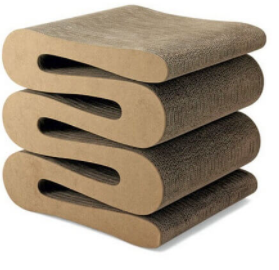
Image source: https://hivemodern.com/pages/product243/wiggle-side-chair-frank-gehry-vitra
Frame construction and coverage
In the Beginning of the 1980s cardboard furniture became very popular in France by the technique of Eric Guiomar. It is totally different to the technique of Frank Gehry. The furniture in the technique of Guiomar is made with corrugated cardboard, simple, double and triple groove. First, a frame is created with intertwined cardboard plates which are cut out according to the original design. This is the support frame of the piece. Then, the frame is covered with cardboard that will be “rolled” on its forms to a perfect fit. This technique allows a great freedom in the choice of shapes and materials.

Image source: https://search.creativecommons.org/photos/03580146-1711-4a9c-95f4-f27fa09264f4
Eco furniture
In the U.S. nearly 200 pounds of cardboard per person go to waste. Most is recycled, but some ends up being burned or in landfills, where it’s the 2nd-most common item. Instead of a fiery death, these boxes were upcycled into furniture.
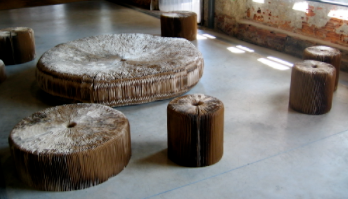
Image source: https://search.creativecommons.org/photos/8fb520a8-41fc-4af8-a8f5-375496b8e995 by neil cummings
Recycled cardboard is broken up into small pieces, soaked in water and turned into a pulp that serves as the base material for furniture, vases, bowls and sculptural pieces. The pieces are molded by hand, dried in the sun, sanded and then a finish is applied. The cardboard which originated as wood, essentially is brought back full cycle by taking on a wood-like quality again.
Cardboard potential
Many have since exploited the natural properties of cardboard, creating appropriate load-bearing structures without the need for connecting material such as glue, and addressing its less desirous properties; cardboard can now be made both waterproof and fire-retardant, thus increasing its durability.
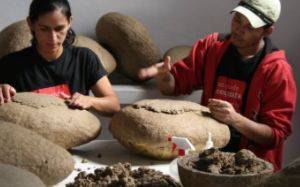
Image source: https://insteading.com/blog/cardboard-furniture/
It is both a light and strong material. As an example, fold theory stools are capable of holding 200kg in weight, but can be folded and packed away with relative ease. The secret lies in both the design and the fold of the cardboard itself, with corrugated or honeycombed forms proving most popular for furniture. Computer programs have greatly aided this process, allowing designers to manipulate these folds to create visually appealing, robust structures.
Ultimately, the current trendiness of cardboard is due not solelyì to its cheapness, but rather to its lower comparable ecological footprint. Its pre-production and production footprint is much lower than more durable material, owing to its recyclability and minimal transportation costs.
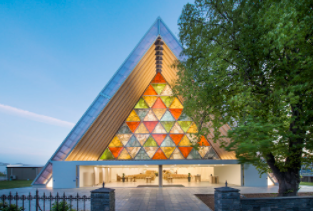
Image source: https://search.creativecommons.org/photos/d3b07449-6570-4fbd-b566-b5bfdadb9815 by 準建築人手札網站 Forgemind ArchiMedia
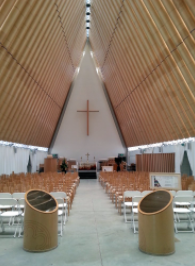
Image source: https://search.creativecommons.org/photos/0240902b-eefa-4d5a-adf7-85a301dcb335 by nzgabriel
Cardboard is now being used as a cost-efficient and portable construction material for trade and show stands and temporary installations, something that can be quickly installed and packed away for future use. Cardboard has managed to succeed where other materials have failed. Its quick, easy transportation and assembly make it ideal for creating temporary housing for those affected by crises, as exemplified by Ban’s incredible work in Japan, Rwanda and New Zealand.
Info sources:
https://www.linkedin.com/pulse/thinking-outside-box-rise-cardboard-furniture-design-farah-beaini
https://www.ft.com/content/65ebb456-97cc-11e3-ab60-00144feab7de
